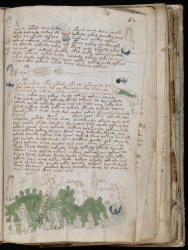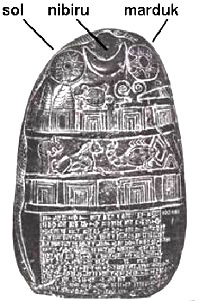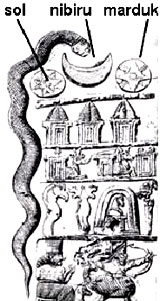|

by
Kithra
from
UFOReview Website
Does anyone remember those ‘O’ and ‘A’ level GCE questions that
began with the words: “compare and contrast?” Don’t panic, I’m not
setting an exam question, and I’m not really going to either compare
or contrast the two documents I’m about to write about. However,
neither text is very well known and the only similarity with
“compare and contrast” is that one is accepted as being a genuine
manuscript, whilst the other is probably a fake.
So I’ll start with the real article.
THE VOYNICH
MANUSCRIPT
The Voynich Manuscript measures
around seven by ten inches, and contains approximately 250 pages,
although it may have originally contained more. Apart from the many
drawings and diagrams, it is written in an as yet unknown language
that is believed to be encoded, but it has eluded all attempts at
deciphering.
Thought to have been compiled in Europe during mediaeval times, it
was discovered in Italy in 1912 by an antiquarian bookseller named
Wilfrid M. Voynich. He found it in a Jesuit College in Frascati and bought it from them. Then, in 1961 he sold it to an
expert on rare books, called H. P. Kraus, for a large sum of
money.
Eight years later Mr. Kraus also
attempted to sell it, for an even larger amount of money, but was
totally unsuccessful. So he donated it to Yale University, who
suspect it might have been written by the British Franciscan cleric
Roger Bacon; who lived between 1214 and 1294. Bacon had an
interest in alchemy and was at one time imprisoned by the church.
Not a great deal is known about the early history of the manuscript,
but it does appear to have been bought by the Emperor of the Holy
Roman Empire, Rudolph II, for the sum of 600 ducats.
He lived between the years of 1552 and
1612 and had a great interest in all things esoteric. When the
document turned up in 1912 it contained a letter, dated 1666, from a
Johannes Marcus Marci, the rector of Prague University. It
was written to Athanasius Kircher, a Jesuit scholar, and
showed the manuscript to have been bought by Emperor Rudolph II.
The document contains a great many
coloured illustrations, amongst which are those seeming to depict:
herbal recipes; unknown plants; charts that seem to show the signs
of the zodiac; strange charts that appear to be depictions of what
would be seen in the sky when looking through a telescope;
microscopic cells; and naked women in bathtubs that seem to show
plumbing.
 
The
Beinecke rare book and manuscript library
at Yale University now houses the Voynich Manuscript. In its
introduction it states that:
“Scientific or magical text in an
unidentified language, in cipher, apparently based on Roman
minuscule characters; the text is believed by some scholars to
be the work of Roger Bacon since the themes of the illustrations
seem to represent topics known to have interested Bacon.”
A history of the numerous attempts to
decipher the manuscript can be found in a volume edited by R. S.
Brumbaugh, “The Most Mysterious Manuscript: The Voynich
“Roger Bacon” Cipher Manuscript (Carbondale, Illinois, 1978).”
At the following Yale University link you can also read a complete
description of what the manuscript comprises, together with an
account of how it actually looks, e.g. colours, subject matter,
writing materials, type of paper, etc: The six sections it contains
are categorized as being:
“Botanical sections; Astronomical or
astrological section; “Biological” section; Sextuple-folio
folding leaf contains an elaborate array of nine medallions,
filled with stars and cell-like shapes, with fibrous structures
linking the circles. Some medallions with petal-like
arrangements of rays filled with stars, some with structures
resembling bundles of pipes; Pharmaceutical section; Continuous
text.”
It also lists the contents of
supplementary material relevant to the document. One of the most
interesting pieces of information on the page states that:
“The identification of several of
the plants as New World specimens brought back to Europe by
Columbus indicates that the manuscript could not have been
written before 1493.”
All of the above can be found
in this report.
 
Of course, there are many websites
either devoted to the Voynich Manuscript, or at least having good
articles about it. One of the best is dedicated to the document and,
on it’s index page reads:
“There is a 16th Century manuscript
called “The Voynich Manuscript,” (often called the most
mysterious book in the world), who’s translation has eluded
cryptographers and linguists for almost a hundred years. This
site is packed with information about it, and offers both a
long, and a short, tour:”
There is also a site that takes a very
intellectual look at the Voynich Manuscript. This has a
mailing list which was begun in 1991 for the benefit of academic
researchers. According to the site it comprises “cryptographers,
linguists, botanists, astronomers, paleographers, medievalists,
historians, astrologers and even a few crackpots,” many with
different approaches and transcribing techniques.
It also includes
the following piece of information:
“The text is written in a neat and
clear script which has defied attempts at interpretation by some
of the best cryptographic minds available including
Athanasius Kircher; noted cryptologist Brig. John Tiltman,
head of the British codebreaking establishment at Bletchley Park
during World War II; and William F. Friedman, the famous
American code breaker who turned cryptanalysis into a science
and led the team that broke the Japanese Purple cipher machine.”
You can find the site
here.

Computer analysis of the text show there
are two “languages” being used, Voynich A and Voynich B.
Since 1919, there have been various attempts to decipher the code,
but it seems that the text cannot be simply changed into, e.g.
English, Latin, etc: However, two separate attempts were made by
W. Friedman and J. Tiltman, who both came to the
conclusion that the language was artificial.

As with many other artifacts of unknown
origin there have been shouts of “Hoax!” especially as the document
still remains almost totally un-deciphered. Some would maintain that
it was a 16th Century fake that was done simply to sell to the
Emperor Rudolph II for a very large amount of money, given his
interest in so many arcane things. However, the idea of it being a
forgery has not been proved.
A short list of some of those who have
tried to crack the cryptography of the code
in this report.
However, a psychologist, Dr. Gordon
Rugg, who teaches computer science at Keele University, in the
UK, believes he may have a very good idea as to how the text was
created. But he came to his conclusions using the good old-fashioned
paper and pen method, rather than using a computer. In the days of
Queen Elizabeth I she had an astrologer named
John Dee. He had an assistant called Edward Kelley,
who most modern historians now believe to have been a fraud.
But Kelley was very interested in
cryptology and Rugg thinks he may well have faked the Voynich
Manuscript. So he used one of Kelley’s methods, a grid of 40
rows and 39 columns to make a table. He then filled it in with
syllables from the document and put a lattice made from cardboard on
top of it. This frame comprised three squares in a diagonal pattern,
and he began to make words by reading each syllable as he moved the
grid across the columns and down the rows. All of which resulted in
producing the same internal patterns as those found in the
manuscript.
Dr. Rugg calls the approach he used
the Verifier Approach; which
addresses what might be called the “expertise gap” in the academic
world. Whilst doing his research Dr. Rugg discovered a mechanism,
called the Cardan Grille, which had first been depicted
around 1550 by Girolamo Cardano.
How to Create an “Indecipherable” Manuscript:
1. Stock a grid with randomly
generated prefixes, midfixes, and suffixes.
2. Using heavy card stock, cut a three-slot grille that
exposes word fragments.
3. Work through the table, placing the grille over three
cells to form a new word.
4. Copy the words onto the manuscript page.
5. To vary the pattern, periodically cut a new grille and
repeat steps 3 and 4.
Dr.
Gordon Rugg also has his own web site.
Here he explains his work on the Voynich Manuscript, and the
conclusions he came to.
In early February 2006 a UK TV station, BBC4, broadcast a
documentary about the Voynich. It set out several different theories
as to what the manuscript might mean, and
you can read an interview with the director
here.

Finally, for a very different
perspective, James Finn, the author of “Pandora’s Hope,”
says that he believes the Voynich code might have been as
follows:
“It was encoded. But not by the
logical method, the mathematical method of encoding they were
looking for. It was visually encoded.”
And in an article at this link he sets
out his reasons, with examples, for thinking about it in this way.
It makes a highly intriguing read.
In all probability the real truth
behind the Voynich Manuscript will never be known.
THE KOLBRIN
BIBLE
Apparently the Kolbrin Bible is a collection of ancient texts
that are contrary to, or an alternative of, the official version of
the Bible. However, there really isn’t very much information about
it to be found on the Internet.
It actually comprises two books, “The Kolbrin” and “The
Gospel of the Kailedy.”
The preface of the first book states
that it contains a collection of documents from various sources,
although many have been damaged over time and are thus only
partially complete; while the other volume is an ‘unknown’ version
of the New Testament. But, whether real or a hoax, both
volumes are controversial, and the whole subject seems to have come
to light in relation to the study of predicted devastating earth
changes; especially during what many believe are The End Times.
It would seem that
the Culdian Trust are the
‘guardians’ of this work.
In
the Foreword they state:
“Although it formulates a
distinctive spiritual philosophy, this book is not claimed to be
anything other than a transmitter of ageless wisdom. It serves
the common cause, the common good and the common man through
presentation in a particular form.”
And in
the Introduction they say that:
“The Kolbrin, in its present
production, incorporates a body of enlightened teachings which
are the treasure of the centuries, a light on the path of Truth,
and as applicable to the world today as they were in the past.
There has, however, been a considerable amount of
reconstruction, as the original writings survived only
precariously. Most of what is presented here was actually
salvaged from a pile of discarded manuscripts that was partially
burned and damaged by the weather before being reconstructed
into manuscript from which this is rewritten.”
According to the site The Kolbrin
originally came from Glastonbury Abbey, with the documents
being saved from a fire in 1184 and then kept secretly. They
add that:
“Since then, much of the original
text was lost or destroyed due to the passage of time, their
environment and human error. Each caretaker though, has gone to
painstaking efforts to preserve what was left and to fill in the
gaps with the correct knowledge in order to preserve the
original meaning.”
Then, about 200 years later it fell into
the possession of John Culdy who lived in Scotland, and
became known as “The Bronzebook of Britain.” During which
time the remnants of other ancient texts, known as “The Coelbook,”
also became integrated into it.
Included the text of a note, describing some
of the document’s origins, that was reputedly
found within the
covers of an old copy of The Kolbrin.
THE BRITAIN
BOOK
In an article at the Ufodigest it suggests that:
“The Kolbrin is more significant
than a mere religious history lesson. It is the first
Judaic/Christian document that binds our scientific
understanding of human evolution with creationism and
intelligent design. The mathematical principles from the Kolbrin
reflect the ancient interest of the Druids in the stars,
mathematics and global catastrophe. The Kolbrin speaks of the
return of the “Destroyer” planet, a dark star that has caused a
disaster in the past and is predicted to do so again.”
It also puts forward the idea that The Kolbrin may be the Bible of the Ten Lost Tribes of Israel.
As a book of prophecy The Kolbrin may well imply global catastrophe
from a celestial object. Writing on Andy Lloyd’s DarkStar web site,
Greg Jenner talks of The Kolbrin Bible and suggests that passages in
it might be
describing a fly-by from Nibiru, a.k.a. Planet X.
Half way down the page, just after a
‘critique’ of Andy’s book,
Greg quotes from “The Book of Creation,”
Chapter Three, and concludes by saying:
“With passages like these I tend to
put much weight in what the text has to say—a planetary
encounter. Yes, I realize ancient manuscripts have certain
built-in biases and exaggerations dependent upon the point of
view of the author but at the same time you simply cannot just
throw a precious document like this out with the bath water.
Therefore it is reasonable to suggest the Destroyer mentioned in
the Kolbrin, is in fact
Nibiru, the celestial Sky Monster
accompanied with a red meandering comet-like serpentine tail.
This dovetails the symbolic trinity associated with ancient
Sumerian tablets that I believe portrays Sol, Marduk, and
Nibiru
(with its comet-like serpentine tail).”
 
This book looks at The Kolbrin as having
a message from ancient times, about global catastrophes, that
contain a warning for us today.
You
can read the book review here.
Is The Kolbrin real, or yet another hoax? It’s very hard to tell,
but the suspicion is that it is possibly nothing more than a hoax.
So, if you have any real evidence that could help to prove its
provenance, or otherwise, I’d be more than happy to receive it.
|









